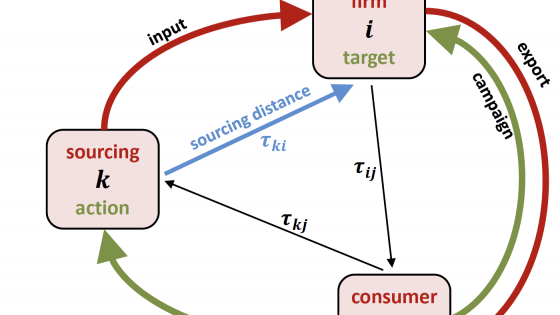Economic globalisation faces a legitimacy crisis that is fuelled by scandals along the globalised value chains characterising modern-day international production. The collapse of the Rana Plaza factory building in Bangladesh in 2013 is an example that received global attention. Campaigns by internationally active advocacy (or watchdog) non-governmental organisations (NGOs) like Greenpeace, Rainforest Action Network, China Labour Watch, etc. play a key role in exposing and creating awareness of what they consider ‘unethical’ practices in international value chains. These NGOs and their campaigns are key mediators of the general criticism of economic globalisation, which has emerged over the past decades, and which has culminated in the so-called ‘globalisation backlash’ of recent years (Rodrik 2017, Pastor and Veronesi 2018, Colantone et al. 2021).
How do advocacy NGOs respond to economic globalisation and how do global sourcing and exporting decisions of firms shape the internationalisation of NGO campaigns?
In the context of global value chains and difficulties in directly targeting independent upstream suppliers, NGOs have adjusted their strategies and resort to value chain campaigns (Baron 2016). In these campaigns, NGOs target large downstream firms with well-known brands for infringements by upstream suppliers even if the firms have no legal control over their suppliers. Over the last decades, a large number of firms from a diverse set of industries have become the targets of international value chain campaigns. These observations suggest that the internationalisation and geographical structure of NGO campaigns are closely intertwined with the patterns of global production and trade.
In a recent paper, we use a unique recently available dataset on NGO campaigns against firms to shed some light on the internationalisation of such campaigns (Koenig et al. 2021). The data are collected by Sigwatch, a consultancy firm that provides international corporations with daily monitoring of NGO activity in their sector and has first been used for academic research in Hatte and Koenig (2020). Our dataset contains 102,532 campaigns by 4,343 NGOs targeting 11,429 firms from 145 countries over the 2010–2019 period.
The data provide information on the international structure of NGO campaigns that goes beyond the dyadic information on location of an NGO (country j in Figure 1, Panel A) and the location of the targeted firm (country i in Figure 1, Panel A). For each campaign, the data includes the ‘action country’ (country k in Figure 1, Panel A), meaning the country where the criticised action occurred or protests took place.
Figure 1 The geography of NGO campaigns
Panel A: Social activism
Panel B: Social activism and economic activity
Notes: Panel A shows the geography of NGO campaigns in the Sigwatch data. Panel B displays the introduction of international sourcing and international trade in final goods (in red) which adds an economic dimension. In this context, bilateral distances as a proxy for trade costs matter, most notably the ‘sourcing distance’ τki, which does not involve the NGO country but nevertheless affects campaigns originating from country j.
Clearly, the action or the targeted firm – or both – may be in the same country as the NGO. The structure of the data illustrated in Panel A of Figure 1 then allows us to gain a new perspective on the internationalisation of NGO campaigns. Especially, it helps to reconcile two seemingly contradictory views on NGO activity: while it is a very local/domestic activity (with local volunteers and donors who are best mobilised for issues they can relate to), NGO activity is also highly internationalised, tackling the pressing issues of a globalised world economy. Figure 2 shows how the Sigwatch data can be used to reconcile these perspectives. NGO activity in the data is indeed strongly domestic, with 74% of campaigns having the targeted firm and/or the action in the same country as the NGO (j = k, j = i, or both). But it is equally true that NGO activity is highly internationalised, with 60% of campaigns with the targeted firm and/or the action in a foreign country (j ≠ i, j ≠ k, or both). The middle part of the graph shows how these two findings can be reconciled: 34% of campaigns have one element in the same country as the NGO and one element in a foreign country.
Figure 2 Sigwatch campaign data (2010-2019)
Notes: The total number of campaigns is 102,532.
Our approach to reconciling this combination of a strong home-bias with a substantial internationalisation is to link the pattern to the internationalisation of production. NGOs rely on the local support of donors, volunteers, and activists and therefore focus on issues these motivated agents can best relate to. However, international trade and the internationalisation of production adds an international dimension to issues that have local relevance. Our analysis of international NGO activity is therefore based on research in international trade, especially the gravity literature (see Head and Mayer 2014) and is also informed by recent research on global value chains (e.g. Amador and di Mauro 2015, Antràs and Chor 2021). As a matter of fact, in a globalised world economy, attractive targets for a (domestic) campaign (firms with well-known products with a large domestic market share) may well be foreign firms. Similarly, to the extent that firms internationalise their value chains, even a campaign against a domestic firm may tackle an issue in a foreign country.
This economic layer of global production and sourcing is illustrated by the red elements in Figure 1, Panel B. Note that adding this economic dimension and interpreting the internationalisation of NGO campaigns as a response to it, introduces bilateral distances as standard proxies for trade costs between all three countries. Most notably, the ‘sourcing distance’, i.e. trade costs τki, between the sourcing (action) country k and the firm country i emerges as a determinant of international NGO campaigns.
The Sigwatch data further reveal a second interesting set of stylised facts concerning the heterogeneity of both firms and NGOs. Typically, the distribution of the number of campaigns initiated by a given NGO as well as, at the receiving end, the distribution of campaigns across firms are highly skewed. Figures 3 shows that about 20% of NGOs account for about 80% of campaigns and about 80% of campaigns go against roughly 20% of firms.
Figure 3 Distribution of NGO campaigns
Based on the patterns in the Sigwatch data and our approach of reconciling the strong domestic and strong international component of NGO campaigns by linking it to global production and trade, we analyse a model of international trade and global sourcing in which heterogeneous NGOs campaign against heterogeneous firms in response to infringements along their international value chains. The model highlights how the geography of international NGO campaigns is shaped by their target firms’ international sourcing and trade activity. That is, we explicitly model the elements depicted in red in Panel B of Figure 1 and analyse how the international sourcing activity as well as trade in final goods shape the patterns of the green elements, for which we have counterparts in the Sigwatch data. Our model shows that international activism can be characterised by a triadic gravity equation in which bilateral trade costs between the country of the NGO, the country of the firm, and the sourcing country matter for the geography of NGO campaigns.
Using data at the NGO and the country level confirms the implications of our theoretical framework, revealing that the same trade cost parameters that shape international trade in intermediate and final goods also shape the triadic patterns of international NGO activity. Specifically, we find strong support for the predicted effects of trade cost variables, both in the NGO level and the country level estimations. Most notably, the distance between country k and country i (the ‘sourcing distance’ in Figure 1, Panel B) has a highly significant negative effect on NGO campaigns.
Our analysis sheds new light on an agent in the international economic policy arena that has, in our view, received too little attention by economists: advocacy (watchdog) NGOs. Using campaigns and consumer boycotts to pressure firms into implementing ‘ethical’ technologies, NGOs interfere with the organisation of international value chains and therefore with the efficiency of the division of labour in the global economy. From a policy and political economy perspective, they also are key mediators of the general criticism of economic globalisation, which has emerged over the past decades and which has culminated in the so-called ‘globalisation backlash’ of recent years.
We therefore view it as imperative that economists include the activity of civil society actors like NGOs into their analysis of different aspects of globalisation in order to be in a better position to analyse current trends of economic globalisation.
References
Amador, J and F di Mauro (2015), “The age of global value chains”, VoxEU.org, 9 September.
Antràs, P and D Chor (2021), “Global Value Chains”, CEPR Discussion Paper 15908.
Baron, D P (2016), “Self-Regulation and the Market for Activism”, Journal of Economics & Management Strategy 25(3): 584–607.
Colantone, I, G Ottaviano and P Stanig (2021), “The Backlash Against Globalization”, in G Gopinath, E Helpman and K Rogoff (eds.), Handbook of International Economics vol. 5, Amsterdam: North-Holland, forthcoming.
Hatte, S and P Koenig (2020), “The Geography of NGO Activism against Multinational Corporations”, World Bank Economic Review 34(1): 143–163.
Head, K and T Mayer (2014), “Gravity Equations: Workhorse, Toolkit, Cookbook”, in G Gopinath, E Helpman and K Rogoff (eds.), Handbook of International Economics vol. 4, Amsterdam: North-Holland, pp. 131–195.
Koenig, P, S Krautheim, C Löhnert and T Verdier (2021), “Local Global Watchdogs: Trade, Sourcing and the Internationalization of Social Activism”, CEPR Discussion Paper 15878.
Pastor, L and P Veronesi (2018), “A rational backlash against globalization”, VoxEU.org, 28 September.
Rodrik, D (2017), “Economics of the populist backlash”, VoxEU.org, 3 July.










